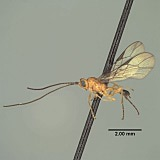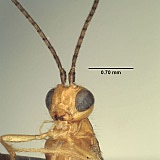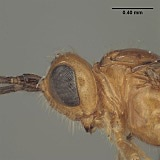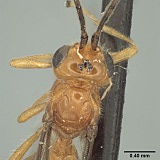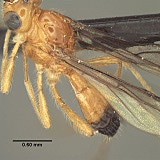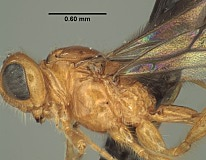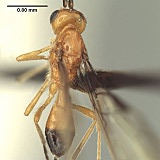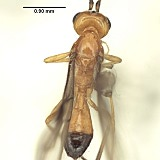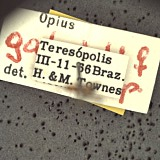Opius gabrieli Fischer
AEIC (examined).
Opius gabrieli: Fischer 1971: 68 (catalog).
Opius (Merotrachys) gabrieli: Fischer 1977: 655–657, 675–676 (key, redescription); Fischer 1978: 166 (range expansion, allotype); Fischer 1979: 264–266 (key); Yu et al. 2005, 2012 (electronic catalogs).
Opius gabrieli is nearly identical to O. ingenticornis , O. melchioricus , and the newly described O. rojam . All four species have very short ovipositors (as in Fig. 1), heavily sculptured propodea (as in Figs 6, 8), thinner, pale setae on the basal flagellomeres (Fig. 2), and are predominantly orange. Opius antennatus , O. matthaei , O. petri , and O. raphaeli are darker but otherwise share these features and together these eight species form a larger subgroup within the ingenticornis species group. Opius gabrieli is most readily recognized by the black apical metasomal terga relative to O. ingenticornis , O. melchioricus , and O. rojam . O. ingenticornis and O. rojam are more uniformly orange and the face is more completely shagreened than in the other two species whereas O. melchioricus has the tegula black with dark transverse lines across the posterior margins of the meso- and metathorax. Opius filiflagellatus provides an interesting contrast since the propodeum is extensively carinately rugose and the metasoma is intensely shagreened anteriorly as in O. ingenticornis , but the setal pattern on the basal flagellomeres do not match those of the subgroup delineated here.
Additionally, as in all other members of the ingenticornis species group, this species can be further characterized as follows: Mandible short, broadly triangular, dorsal margin strongly angled ventrally, broadly exposing labrum (Fig. 2). Clypeus shaped as a broad crescent, nearly hemispherical, flat to weakly protruding ventrally, ventral margin shallowly concave, rarely appearing truncate. Malar sulcus distinct, complete. Antenna unusually long (Fig. 1), approximately twice longer than body; first flagellomere slender, longer than second, with long, narrow plate sensilla. Occipital carina broadly absent dorsally, the gap in dorsal view at least as wide as distance between eyes; carina well developed laterally and ventrally, widely separated from hypostomal carina ventrally. Pronope (Fig. 4) deep, wide, posterior margin at least weakly overlapping base of mesoscutum, thus obliterating posterior transverse sulcus medially; vertical carina absent on pronotum laterally. Mesoscutum without midpit; notaulus short, curved, pit-like anteriorly, narrowing and evanescent posteriorly. Propodeum with median depression at least anteriorly, never with median longitudinal carina. Mesopleuron without sternaulus, precoxal sulcus unsculptured, absent or very faintly indicated; hind margin of mesopleuron not obviously crenulate on dorsal 0.5. Fore wing 2CUb arising from or near middle of first subdiscal cell. Hind wing with RS distinctly infumate; m-cu absent. T1 with dorsal carinae parallel or nearly so, extending from base to apex; laterope large, deep; dorsope absent.
There are no specimens currently determined for this OTU, or those specimens determined for this OTU are not yet mappable.
Second label is a white Opius gabrieli sp. n. det Fischer holotype label. There is also a yellow institutional label.
This material is based upon work supported by the National Science Foundation under Grant Number DEB 0949027 and associated REU supplement 1213790.
Any opinions, findings, and conclusions or recommendations expressed in this material are those of the author(s) and do not necessarily reflect the views of the National Science Foundation.

